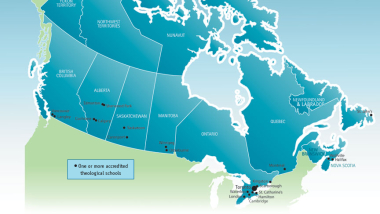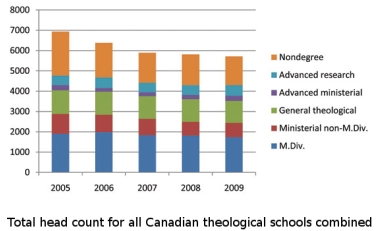
Nobel Prize-winning economist Paul Krugman recently commended the Canadian banking system for being boring. Canada's financial lending institutions may seem dull, unimaginative, and over-regulated, he wrote in the January 31, 2010, issue of The New York Times, but "when it comes to banking, boring is good," especially during times of economic meltdown.
What's true of Canada's banks may also be true of its seminaries. Compared to their U.S. counterparts, theological education in Canada seems modest and unimpressive. Yet many of Canada's theological schools are hardy and display remarkable staying power, even during challenging times. Sandra Beardsall, who teaches at St. Andrew's College in Saskatoon, suggests a reason for this: Many Canadian theological schools "have their own ‘thickness' of being," she wrote in an article that appeared in Theological Education in 2008 — "buildings, endowments, lectureships, alumni, emeriti, and grand narratives of triumph and tragedy." That said, boards committed to shepherding these schools through stormy seas have always found it a challenge to balance economic equilibrium with fulfilling mission in the unique Canadian context.
Canada's unique attributes
That context provides more than economic challenges for theological schools. A land of vast distances and rich natural resources, Canada's landmass of nearly 10 million square kilometers (nearly 4 million square miles) has a population of only 34 million, which is regionalized and lives mostly within 100 miles of the U.S. border. First populated by aboriginal groups (Canada's "First Nations"), the land was colonized by the French and the British. Immigration patterns during the past century have made the country urban and multicultural. Both English- and French-speaking Canadians continue to wrestle with questions of national identity, regional diversity, and justice for Canada's aboriginal peoples.
Canada's proximity to the United States is a big issue. The social, political, and cultural differences between the two countries may not seem significant at first glance, but they are. To be sure, Canadian and American theological schools share similar religious histories and a common task in education, as well as a common cultural milieu of popular entertainment and sports, and a common continental economic continuum. And it's true, as Canadian journalist John Ibbitson points out, that "over the years, and with the patriation of the Constitution (in 1982), Canadian society has evolved away from the British model and toward the American." Yet, in many areas, Canada "straddles the elite-driven society of Great Britain (and the rest of Europe) and the populism of the United States," Ibbitson says. For example, Canadian society remains one "that values order as much as freedom, where arguments in favor of the common good are likely to trump those defending individual liberty." Americans have lower taxes and private health care; Canadians have higher taxes and public health care. Americans pursue life, liberty, and happiness; Canadians value peace, order, and good government. When Americans think of the longest undefended border in the world, they think security; when Canadians think of the same border, they think trade.
Religiously, Canadians live in what McGill philosopher Charles Taylor famously calls "a secular age," with people of Christian faith, people of other religious faiths, and people of no religious faith at all. Census figures show that 43 percent of Canadians identify themselves as Roman Catholic, while 23.5 percent are Protestant. Among the Protestants, the largest denomination is the United Church of Canada (a 1925 union of Methodists, Congregationalists, and some Presbyterians), followed by Anglicans, Baptists, Lutherans, Presbyterians, Pentecostals, and various evangelical groups. Muslims account for roughly 2 percent of the population and growing, while Jews, Buddhists, Hindus, and Sikhs account for approximately 1 percent each.
Those figures don't tell the whole story. Between 1961 and 2001, the level of those not attached to any religious body grew from just half of one percent to 16 percent. Catholic affiliation has stayed relatively steady — in 1961 it was 46 percent; in 2001 it was 43 percent — but this masks the reality that Quebec, the most Catholic of the provinces, has become a thoroughly secular society. The "Quiet Revolution" of the 1960s signaled the end of a society dominated by the church and the emergence of a new Quebec national spirit. Another significant piece of the story is the virtual collapse of the hegemony of the mainline Protestant traditions that were part of English Canada's founding fabric — mainline affiliation has dropped from more than 40 percent to just over 23 percent. There has, however, been a modest upsurge among evangelical churches, and other religious traditions have emerged in small but significant numbers. Protestant and Catholic numbers are bolstered by recent immigrants from places like Korea, China, Africa, Latin America, and the Philippines.
Strengths and limits
 |
|
Schools reporting: 35 (except 34 in 2007)
(Source: ATS Annual Data Tables)
|
At last count, 33 Canadian institutions are fully accredited members of the Association of Theological Schools — more than 10 percent of all ATS schools — and most of the 33 are also members of In Trust. Canada has roughly one seminary for every one million people while the United States has one for every 1.5 million people. On the other hand, U.S. church attendance is twice what it is in Canada, and more U.S. residents identify themselves as Christians. U.S. taxpayers also have more benefits for charitable giving, so it's not surprising that U.S. residents offer more private support for theological education. Since Canadian theological schools have a smaller population and fewer financial resources, observers like Stanley E. Porter of McMaster Divinity College have argued that in the near future, Canadian churches will not be able to support the current number of theological schools.
Mainline Protestant and Roman Catholic schools already feel this acutely. The United, Anglican, Presbyterian, Lutheran, and Baptist churches have multiple denominational schools across the country, but most are small and rely on their historic affiliations with public universities and participation in ecumenical consortia. Roman Catholic theological education is also in crisis, and numerous established institutions have been closed in the last few decades.
While Canadian schools constitute more than 10 percent of all ATS schools, student enrollment tells a different story. Far fewer than 10 percent of students in ATS schools attend Canadian seminaries. Fewer than 6,000 students are now enrolled across Canada — down from nearly 7,000 in 2005-2006. The percentage of part-time students in Canada is also higher than in the United States. The average size of a theological school in Canada is about half the size of a U.S. seminary — about 182 students compared to 350. Notably, fewer than a third of ATS schools in Canada are evangelical, but on average they enroll more than twice the number of students that enroll in mainline Protestant schools. In fact, the two largest Canadian theological schools are in the evangelical tradition: Regent in Vancouver and Tyndale in Toronto.
Historically, the relatively larger proportion of Roman Catholicism in Canada has meant that theological education has been conducted largely as "two solitudes," with only limited interaction between Catholics and Protestants. Moreover, in Quebec, an entire culture of theological education exists completely apart from ATS — francophone schools like l'Université de Montréal, le Séminaire de Québec, and l'Université Laval, as well as the English-language Concordia University. Schools established for aboriginal theological education are also widely scattered across the country.
In Canada, education is part of the jurisdiction of the province. Theological schools possess provincial degree-granting charters and are governed by provincial educational standards. Some, but not all, receive government funding. In addition to ATS, In Trust, the Wabash Center for Teaching and Learning in Theology and Religion, the Fund for Theological Education, and Auburn Seminary's Center for the Study of Theological Education, Canadian theological educators also draw on their own resources, including the Churches' Council on Theological Education (sponsored by some United, Lutheran, Baptist, Presbyterian, Catholic, and Anglican bodies) and the Christian Higher Education Council (affiliated with the Evangelical Fellowship of Canada). From time to time, Canadian theological educators muse whether Canadian schools should have their own uniquely Canadian accrediting agency.
But Canadian theological educators have to reckon with real limitations.
■ Doing research-level theology without a strong indigenous publishing industry is a challenge.
■ Few schools offer world-class doctoral programs.
■ There is limited funding for theological teaching and research, both public and private.
■ Most theological schools offer marginal salaries.
■ The small size of most student bodies makes it difficult to offer many specialized electives or focused programs.
Perhaps the most challenging fact of all is the continuing lack of a recognizably "Canadian" approach to academic theology.
Shifting ground
For all these reasons and more, those who lead and govern Canada's theological schools face significant challenges in a changing context.
First, there is the changing relationship of theological schools with the culture. Once at the center of the educational enterprise, theological schools now find themselves on the margins. In some provinces, theological schools continue to receive government grants, either directly or indirectly through affiliations with public universities, but such funding is increasingly scrutinized. Institutional affiliation with public universities has often made it a delicate matter to advance confessional claims. The line between church and state was never as sharply drawn in Canada as in the United States, but that appears to be changing.
Second, there is the changing relationship of theological schools to the churches which birthed them. Many churches find it difficult to fund their theological schools as they once did. Increasingly, theological schools are turning to partnerships and ecumenical arrangements to share resources while transforming their boards from bodies that provide oversight and accountability (ensuring the church's interests) to bodies that are generative and fiduciary (looking out for the school's interests). The boards of denominational and university-affiliated schools are beginning to look more and more like the boards of freestanding theological schools.
Third, theological education itself is changing. Like many American seminaries, Canadians are challenged to keep up with the moving target that is theological education today. The schools are all vulnerable to market forces and consumer demands; they must adopt new technologies and new delivery systems; they are forced to examine themselves in light of new accreditation standards; they know they must cater to the changing face of diverse student populations. And they do this with mixed signals from their sponsoring ecclesial bodies. These challenges are not unique to Canada, but they are uniquely shaped by the Canadian context.
Most theological schools in Canada, though modest, have weathered the recent economic storm. The challenge going forward is whether these seminaries, given their history and context, can be transformed to serve a church in Canada that cannot yet be seen. That may well mean a future with fewer schools. According to theologian Douglas Harink of The King's University College in Edmonton, it may depend upon a capacity and willingness to return to theology as the proper subject matter for theological education: "the unsurpassable and all determining reality of God in Jesus Christ, a reality attested in the Holy Scripture and in the people of God created by the gospel." For when all is said and done, the real context of theological education is not the United States or Canada, it is the coming reign of God.
Further reading
■ Sandra Beardsall, "The Church/Theological School Relationship in Canada: A Reflection on Historical and Recent Trends," Theological Education, Vol. 44, No. 1 (2008).
■ Douglas Harink, "Will Theological Education Be Theological?," Toronto Journal of Theology, Vol. 25, Supp. 1 (2009).
■ John Ibbitson, Open and Shut: Why America Has Barack Obama and Canada Has Stephen Harper (McClelland & Stewart, 2009).
■ Jane Barter Moulaison, "Introduction: ‘Is There a Future for Theological Education in Canada?,'" Toronto Journal of Theology, Vol. 25, Supp. 1 (2009).
■ Stanley E. Porter, "Theological Education in the 21st Century," Toronto Journal of Theology, Vol. 25, Supp. 1 (2009).
■ Charles Taylor, A Secular Age (Belknap Press, 2007).
■ Peter Wyatt, "The Canadian Ecology," Theological Education, Vol. 44, No. 1 (2008).